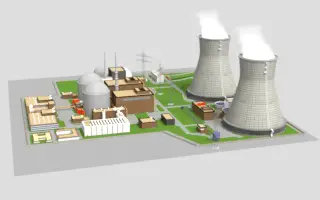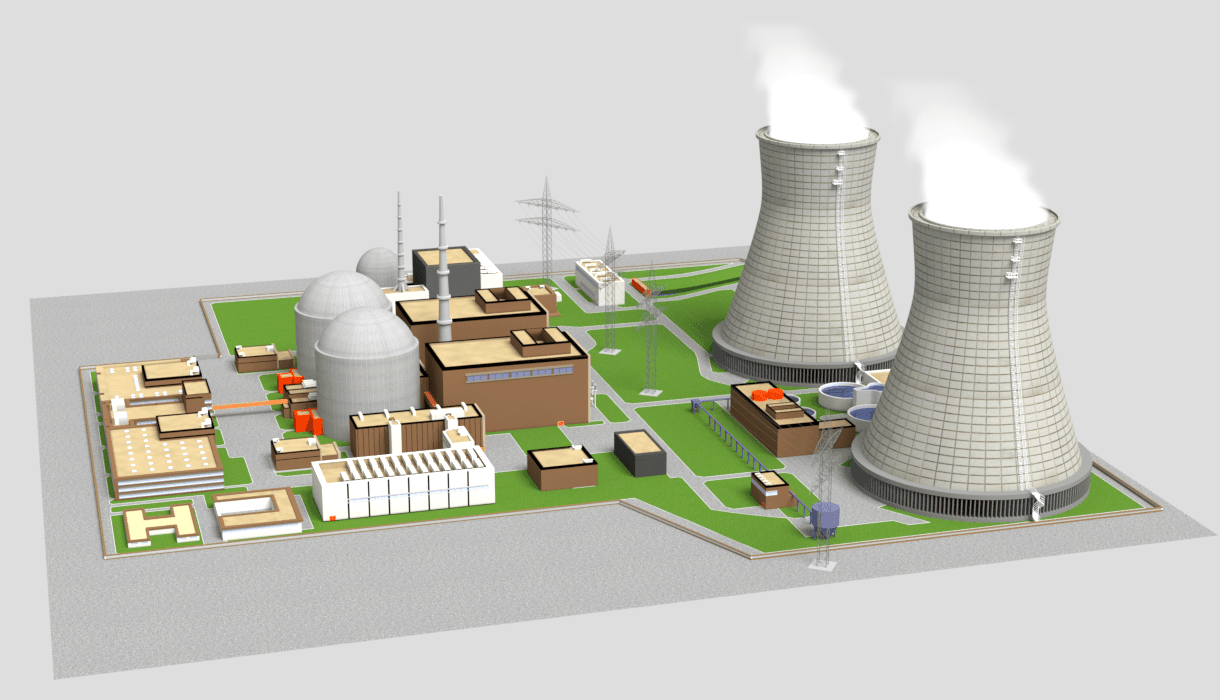
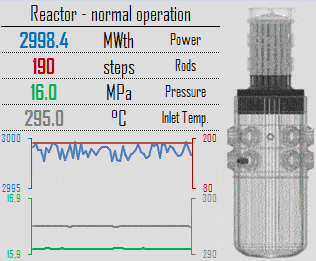
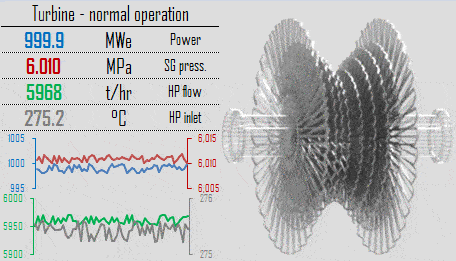
SCRAM – Reactor Trip
A reactor “SCRAM” (or “reactor trip”) is the rapid insertion or fall of the control rods into the core to stop the fission chain reaction. At PWRs, all control rods are usually inserted within two to four seconds. Control rods are an important safety and control system of nuclear reactors, and their prompt action and prompt response to the reactor are indispensable. Control rods are used for maintaining the desired state of chain reaction within a nuclear reactor (i.e., subcritical state, critical state, supercritical state). Reactor Trip System (RTS), which actuates a reactor trip, is a part of a Reactor Protection System (RPS).
In a pressurized water reactor, the control rods are inserted (dropped) from the top of the reactor vessel into the core. In a boiling water reactor, the control rods are inserted from the bottom of the reactor vessel into the core.
A reactor is considered shut down when it is subcritical and sufficient shutdown reactivity exists, so there is no immediate probability of secondary criticality. Despite the chain reaction being quickly broken down, all of the fissions in the core are not stopped. There are always neutrons in the core, and therefore residual fissioning occurs. On the other hand, the amount of heat generated due to the residual fissions (initiated by source neutrons) which are not stopped, and the decay heat is much less than that which can be removed by the plant systems.
SCRAM from Hot Zero Power
Assume a reactor trip from hot zero power (from “zero power criticality”). The power decrease, in this case, does not influence the criticality (keff). In this case, the reactivity of the multiplying system becomes quickly negative and higher than β (i.e., that ρ is negative and ρ ≪ β).
The rate at which the reactor fission rate decays immediately following the shutdown is similar for all reactors, provided a large amount of negative reactivity is inserted. After a large negative reactivity addition, the neutron level undergoes a rapid decrease of about two decades (prompt drop) until it is at the production level of delayed neutrons.
But even if it were possible to insert an infinite negative reactivity, the neutron flux would not immediately fall to zero. Prompt neutrons will be absorbed almost immediately. It is consistent with the prompt drop formula. Therefore the resulting neutron flux will be:
Obviously, the neutron flux cannot drop below the value βn1. The real values are much higher. The integral worth of all control and emergency rods (PWRs) is, for example -9000pcm. It is equal to ρ = -9000/600 = -15β = -0.09. (β= 600pcm = 0.006)
For this negative reactivity, the prompt drop is equal to:
n2/n1 = 0.006/(0.006+0.09)=0.063
which is about ten times higher than in the case of an infinite negative reactivity insertion.
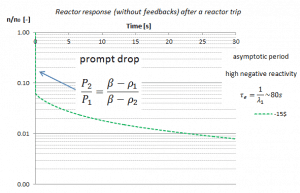 The neutron flux then continues to fall according to the stable period. The first root of the reactivity equation occurs at s0 = – λ1, the decay constant of the long-lived precursor group. The shortest negative stable period is then e = – 1/λ1 = -80s. The neutron flux cannot be reduced more rapidly than this period. On the other hand, the prompt drop causes an immediate drop to about 6% of rated power. Within a few tens of seconds, the thermal power that originates from nuclear fission is below the thermal power that originates from decay heat.
The neutron flux then continues to fall according to the stable period. The first root of the reactivity equation occurs at s0 = – λ1, the decay constant of the long-lived precursor group. The shortest negative stable period is then e = – 1/λ1 = -80s. The neutron flux cannot be reduced more rapidly than this period. On the other hand, the prompt drop causes an immediate drop to about 6% of rated power. Within a few tens of seconds, the thermal power that originates from nuclear fission is below the thermal power that originates from decay heat.
There is an exception to this behavior, and it is a SCRAM of a heavy water reactor. In a heavy water reactor, the photoneutron source is extremely large after shutdown due to the amount of deuterium in the moderator and many high energy gammas from short-lived fission product decay. This high gamma flux from short-lived fission products will decrease rapidly after shutdown. The photoneutron source is large enough to significantly impact the neutron population immediately after shutdown. The photoneutron source results in flux levels decreasing more slowly so that a heavy water reactor will have a significantly larger negative reactor period after a shutdown.
SCRAM from Hot Full Power
For power reactors, the reactor can behave differently at power conditions due to the presence of reactivity feedback. Power reactors are initially started from hot standby mode (the subcritical state at 0% of rated power) to power operation mode (100% of rated power) by withdrawing control rods and boron dilution from the primary source coolant. During the reactor startup and up to about 1% of rated power, the reactor kinetics is exponential as in a zero-power reactor. This is due to the fact all temperature reactivity effects are minimal.
The temperature reactivity effects play a very important role during further power increase from about 1% up to 100% of rated power. As the neutron population increases, the fuel and the moderator increase their temperature, which results in a decrease in reactivity of the reactor (almost all reactors are designed to have the temperature coefficients negative). The total amount of feedback reactivity that must be offset by control rod withdrawal or boron dilution during the power increase is known as the power defect. The power defects for PWRs, graphite-moderated reactors and sodium-cooled fast reactors are:
- about 2500pcm for PWRs,
- about 800pcm for graphite-moderated reactors
- about 500pcm for sodium-cooled fast reactors
See also: Operational factors that affect the multiplication in PWRs
This exactly but in the opposite direction acts after a reactor trip (SCRAM) from the Hot Full Power state (HFP). It is logical as power defects act against power increase, they also act against power decrease. When reactor power is decreased quickly, as in the case of reactor trip, power defect causes a positive reactivity insertion, and the initial rod insertion must be sufficient to make the reactor safe subcritical. Similarly, as in the HZP state, the integral worth of all control and emergency rods (PWRs) is, for example -9000pcm. It is equal to ρ = -9000/600 = -15β = -0.09. (β= 600pcm = 0.006). Also, in this case, a prompt drop occurs. The prompt drop is quicker than the deaccumulation of heat from fuel pellets. For this negative reactivity, the prompt drop is equal to:
n2/n1 = 0.006/(0.006+0.09)=0.063
but the subsequent power decrease is strongly influenced by changes in core (fuel and moderator) temperatures. After reaching stable temperature, the neutron flux may continue to fall (when subcritical) according to the stable period. Obviously, if the power defect for PWRs is about 2500pcm (about 4 βeff), the control rods must weigh more than 2500pcm to achieve the subcritical condition. The control rods must weigh more than 2500pcm plus the value of SDM (SHUTDOWN MARGIN) to ensure the safe subcritical condition. The total weight of control rods is design-specific, but, for example, it may reach about 6000 to 9000pcm. To ensure that the control rods can safely shut down the reactor, they must be maintained above a minimum rod height (rods insertion limits) specified in the technical specifications.
